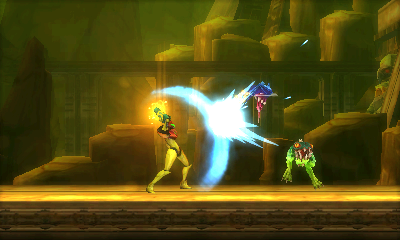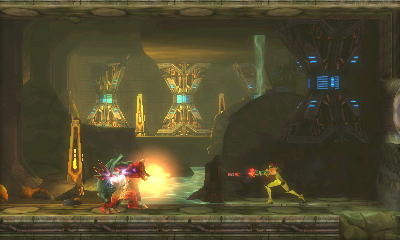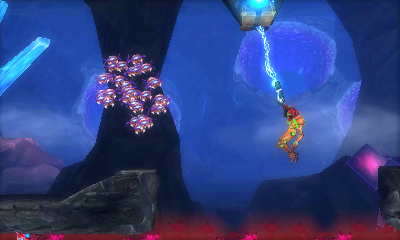Metroid: Samus Returns Review (3DS)

It’s a great time to be a Metroid fan, as the series is making a long overdue comeback with two upcoming games. The first of which is the appropriately-titled Metroid: Samus Returns, a remake of the GameBoy game Metroid II. It takes the core of the game and freshens it up with 3D graphics and modernised gameplay, resulting in a fantastic game for both series veterans and newcomers.
Samus Returns begins with the Galactic Federation recognising the threat that the Metroid species poses to the universe, and sends several teams of soldiers in to exterminate them. When they all fail, bounty hunter Samus Aran is tasked with destroying the Metroids once and for all. Because Nintendo weren’t content they’d done a good enough job of that in recent years. Hahaha I’m just kidding please don’t cancel Metroid Prime 4 I’m very thankful for it. As Samus, you’re left to your own devices on a hostile planet. You don’t have a storyline at the forefront guiding you, you’ve got to find your own way around by exploring and putting your abilities to good use. You start off very vulnerable but over the course of the game you’ll find more and more new powers and upgrades, slowly becoming the full-on badass that Samus is renowned for being.
The alien world of SR388 is brought to life in ways that the GameBoy could only ever dream of. It’s made up of stunning and visually distinct areas that urge you to explore. As you’re granted new abilities you can begin to approach the world in new and interesting ways, some of which defy expectations of how you’d generally approach 2D platformers. Before too long you’ll be crawling along walls and floors or boosting yourself around large open spaces with little respect for the laws of gravity. Seeing as the only explicit story segments are bookends to the game, the environment itself assists in raising questions about the events of the game and directing you along your way. The biggest example of this is in the way you hunt down Metroids. As you progress through the various sections of SR388 you’ll find Metroid husks left behind by the evolving Metroids, which indicate that one is nearby. As you get closer and closer, Samus’ Metroid tracker will gradually beep more and more, raising the tension as it starts flashing red and you know something is about to go down. No matter where you are, there’s always Metroids and other threats out there waiting for you and you have no idea what you could be up against next. But then you gradually get stronger and feel the satisfaction of seeing the Metroid counter gradually tick down to 0 as you slay each one. The game nails the feeling of being alone and having to fend for yourself on an alien world, which is exactly what you want from a Metroid game.
Exploring the environment will help you uncover hidden items that boost your health and ammo reserves. Some of these are easy to find (shoot that suspicious block to unveil a power-up) while others make use of Samus’ arsenal of abilities to provide some interesting puzzles. These sometimes require you to think outside the box and use your abilities in ways they’re not normally used, which keeps things interesting (who’d have thought bombs could be used like THAT!?). In games like this there isn’t always a huge incentive to chase down each and every last collectible because you’re more than powerful enough to complete the game by just collecting a few here and there. Samus Returns alleviates this by providing you with new lore snippets (called Chozo Memories) as you collect every item in each area of the game, which gradually explain the background story of SR388 and its inhabitants. Without spoiling anything, you’ll definitely want to see these.
The planet and its exotic inhabitants are all out to kill you, so it’s a good thing that you’ll have a number of tools, both old and new, at your disposal in order to defend yourself. The one you’ll use most commonly is the new parry manoeuvre that allows Samus to strike enemies with a melee hit that will knock them off balance. At the beginning of the game this makes things a bit slow as you need to take on enemies one at a time and get used to how parrying works, but as time goes on you’ll be pitted against multiple enemies at once. These battles can get hectic because you have different enemies coming at you with their own attacks which require parries at different times, while you still need to actually shoot the enemies you’ve stunned to deplete the numbers. Not every enemy has a parriable attack, however, and instead have their own gimmicks you need to watch out for. Parrying a boss (when you’re able to) will lead to Samus launching into a partially cinematic attack reminiscent of those in Metroid: Other M. She’ll grab hold of the enemy and perform a series of acrobatic manoeuvres to engage the foe while you can fire away with your weapon of choice using the regular controls. These are great to participate in because they further enforce how badass Samus is. Combat now has a nice action focus and pace, which complements the more puzzle/platforming based exploration and adds nicely to the feel of a dangerous world.
Throughout the game there’s a good variety in the kinds of enemies you’ll encounter, which will keep you on your toes. Some of them are a real nuisance though due to the specific ways you need to take them out. The variety of bosses, however, was a bit disappointing but a lot of that is due to the focus of the game being different to other Metroid games. In Metroid Returns you’re solely focused on hunting down Metroids, and so the vast majority of battles are against their various evolutionary stages. Each of these stages requires different approaches, but you’ll encounter each one several times throughout Samus’ journey. There’s only a small handful of boss encounters that aren’t common Metroids which is jarring because the unique and memorable bosses are a big part of Metroid games, and the small number of these bosses stands out when you’re fighting so many Metroids. It’s not inherently a fault of the game, but you need to approach the game with appropriate expectations.
Samus Returns is more than just an updated version of the original game – it features quite a lot of new content. Most of this revolves around items and abilities added into the game that weren’t present in the original, making for new segments of gameplay that utilise them. The most notable of these are Aeion abilities. These are abilities that assist with exploration and combat but drain from your Aeion supply while active. An example is the Aeion-powered shield that can protect you from damage, meaning that you can be presented with situations like a room filled with damaging plants that must be quickly navigated through before your Aeion depletes and you start taking damage. Some series regular items have also been incorporated into the game, like the Grapple Beam which was my personal favourite of the new inclusions – there’s some great platforming segments that utilise it.
For those that would like some more assistance on their journey, in particular those who’ve been turned off by the lack of it in previous Metroid games, Samus Returns does make some available. In sections of the game where you’re required to find multiple Metroids in order to progress, you can return the DNA samples you’ve currently collected to the Chozo device blocking your progress and be given the location of a husk left behind by a Metroid you haven’t killed yet. This doesn’t spell out to you exactly how to progress, but it’s a nice hint to point you in the right direction. On a more general level, you can use the Scan Pulse Aeion ability to mark the surrounding rooms on your map and highlight any hidden destructible tiles in the current room to assist you in finding secrets and paths through rooms.
Having a map available on the touch screen at all times is also a huge benefit. You can see which rooms lead to which just at a glance, and key items and locations such as collectibles and recharge stations will be marked as you encounter them. You can place a set number of custom markers on each zone’s map as well, which can be helpful to mark locations you should return to later when you unlock new abilities. The map is quite small, however, and you can’t zoom it in which makes it hard to tell some of the map icons apart. I spent ages trying to work out which collectible I’d missed in an area, only to realise that I’d mistaken the icon for an extra Aeion charge (a yellow diamond) for an Aeion supply point (a yellow circle).
You can use a few amiibo with Samus Returns, including two new Metroid series amiibo launching alongside the game. Each amiibo has two functions – the first is a reserve tank that will fill up your health or ammo when you’re in a bind. The second function is an unlock outside of the game such as a concept art gallery or sound test. These are rather odd things to lock behind an amiibo since a lot of games offer these for free as unlockable extras. The new Metroid amiibo will unlock a new difficulty mode, which is more of a substantial reward for buying the figure. There are three difficulty modes in the game – the Normal difficulty that the game starts in, a Hard difficulty mode unlocked by beating the game which doubles the damage dealt by enemies, and Fusion difficulty which is unlocked by the Metroid amiibo and quadruples the damage dealt by enemies. Fusion Mode also equips Samus with her Fusion Suit from Metroid Fusion (hey, it’s like the name!) which is a nice throwback. For more info on what amiibo do in the game, check out our Samus Returns amiibo guide.
Metroid: Samus Returns is sure to help put the Metroid franchise back on the map. It highlights the series’ strengths, combining an incredible atmosphere with engaging gameplay. There’s plenty on offer regardless of whether you’re a longtime series fan or new to the series. For veterans it has brand new segments of gameplay and lore, and for those who haven’t played much Metroid it includes a few tools to ease you into the series’ gameplay. MercurySteam have done a wonderful job reimagining the original game and I’d be happy to see them take on a new installment in the series.
Metroid: Samus Returns launches September 16th for the 3DS family of systems, alongside the Samus Aran and Metroid amiibo figures.
This review was written based off a game or game content provided by the publisher. We don’t assign review scores to game reviews.









